Alter ego Alec Tronn First appearance E-Man #1 (1973) | Abilities energy-based | |
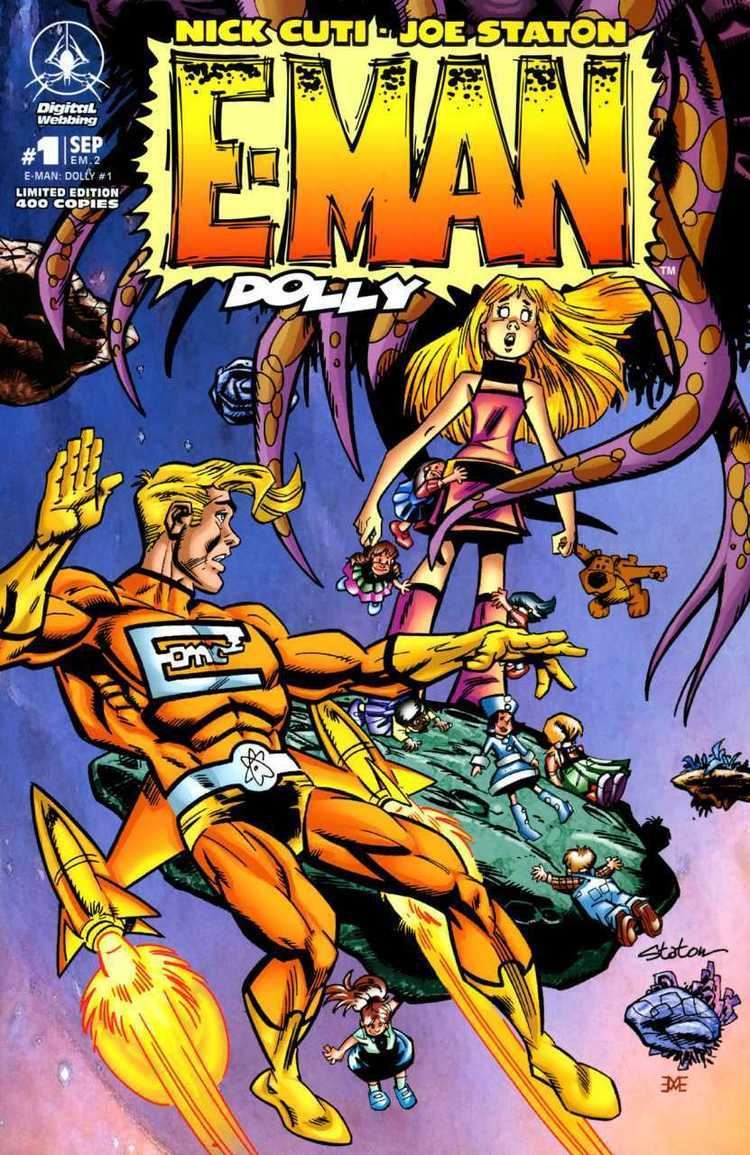 | ||
Similar Rog‑2000, Judomaster, Static, Missing Man, Mocker | ||
E-Man is a comic-book character, a superhero created by writer Nicola Cuti and artist Joe Staton for the American company Charlton Comics in 1973. Though the character's original series was short-lived, the lightly humorous hero has become a cult-classic sporadically revived by various independent comics publishers. Ownership of the character has changed hands over the years, moving from the original publisher to the character's creators.
Contents
- Publication history
- Charlton Comics
- First Comics
- Later publications
- Fictional character biography
- References
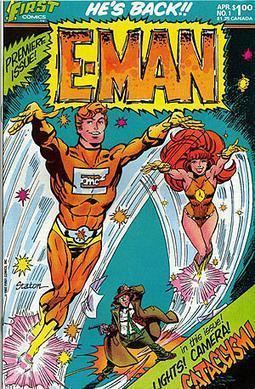
Publication history

After editor Dick Giordano left the Derby, Connecticut-based Charlton Comics, in 1968, the publisher ended its superhero line. A later editor, George Wildman, persuaded the publisher to try superheroes again, leading writer Nicola Cuti and artist Joe Staton to devise E-Man.

Cuti said in the 2000s that his inspirations included the Golden Age of Comics superhero Plastic Man, and that he wanted to create a similarly fun and whimsical character. Cuti also admired Albert Einstein and his formula, E=mc2. He conceived a character who was caught in a factory explosion and became an energy being that could take any form of matter. When he shared this idea with artist Joe Staton, Staton felt the origin was too similar to that of Charlton's Captain Atom and the atomic-accident origins that had often been used by Marvel Comics writer-editor Stan Lee. Inspired by the works of Arthur C. Clarke, Cuti created a new origin that made E-Man a packet of sentient energy created as a star went nova.

Cuti asked Staton to design the costume, only requiring that the character not wear a cape and that the formula E=mc2 be his chest emblem. Staton based E-Man's face on that of actor Roger Moore, making him appear heroic but somewhat generic. When Staton delivered his design to Cuti, Cuti colored it with yellows and oranges to differentiate it from the reds and blues so frequently in other superhero costumes.

E-Man took a light whimsical tone to differentiate itself from super hero comics at Marvel and DC. Cuti enjoyed scripting wisecracking banter between E-Man and his girlfriend, Nova Kane, inspired by movies like The Thin Man and Mr. and Mrs. North. However, he did not intend to spoof superhero comics. He wanted to present serious situations that the characters could make light of. Inspired by the work of Wally Wood in MAD magazine, Staton would insert sight gags into each issue.
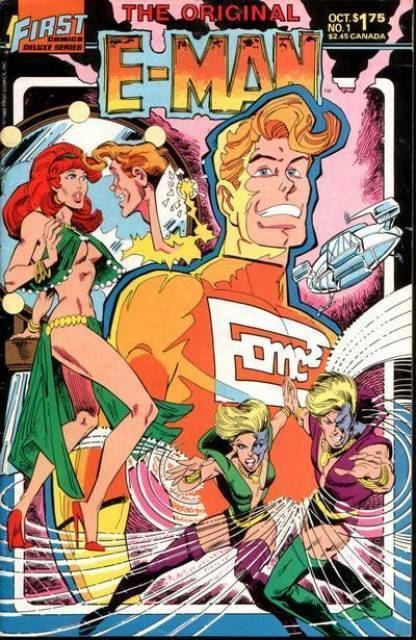
Cuti promoted E-Man in advance of the first issue by sending letters to assorted fanzines, such as Rocket's Blast ComiCollector and The Comic Reader, with a photostat illustration of the titular hero. The letter announced Charlton's re-entrance into the superhero genre and promised that one-third of each issue would feature a new superhero, an idea suggested by Wildman to try out new superhero properties.
Charlton Comics
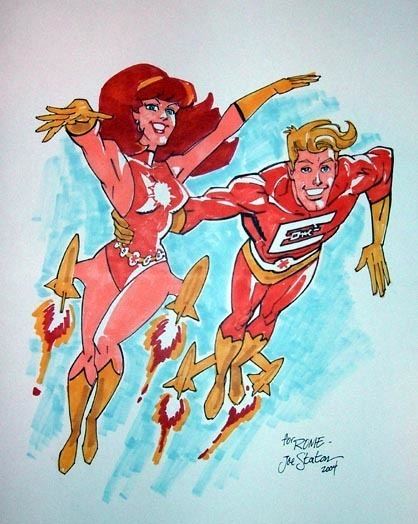
E-Man first appeared in E-Man #1, cover-dated October 1973, on a bi-monthly publishing schedule. The series ran for 10 issues until cover date September 1975. Cuti suggested the title "E-Mail," for the series' letter column, a term not yet in prolific use. The last four issues, along with other Charlton titles, featured painted covers after Charlton began working with a Texas company that could do painted color separations cheaper than Charlton could do hand separations.
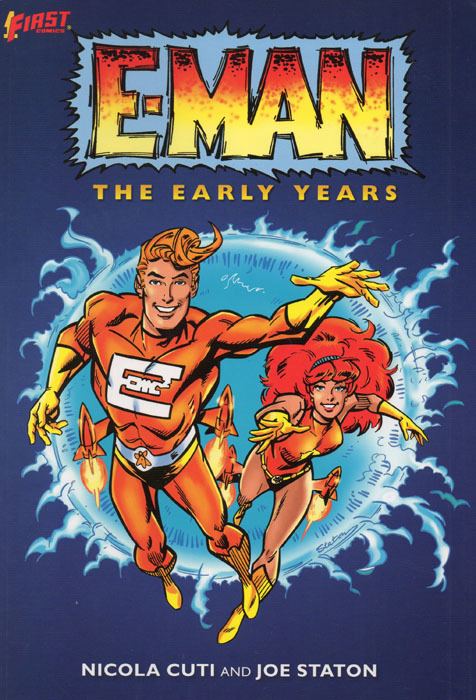
Due to a nationwide paper shortage caused by a Canadian paper mill strike, six months passed between issues #2 and #3. This gave Cuti and Staton time to push other material back and produce a story titled, "The Energy Crisis," a social commentary on the 1973 oil crisis. This gap in publication also gave Staton the opportunity to refine the title's art style, making it darker and conveying more mood.
E-Man was Charlton's lowest selling title on newsstands, but was the company's best selling subscription. When Wildman told Cuti that the title was to be cancelled after issue #10, he explained that the publisher only allowed it to continue publication to that point out of loyalty to Cuti. CPL Gang publisher Bob Layton agreed to publish E-Man stories in the fanzine Charlton Bullseye, but only a single story saw print, "...And Why the Sea Is Boiling Hot" in issue #4 of that title.
Each issue of E-Man featured a backup story, with the single exception of issue #8.
A supporting character, the grubby but right-hearted detective Michael Mauser, got his own backup series in Charlton's Vengeance Squad. In 1977, six issues were reprinted under the Modern Comics label for sale as bagged sets in discount department stores such as North America.
First Comics
When Staton became art director at First Comics, the publisher acquired the rights to the character from Charlton and launched a second series. First approached Cuti to write the title, but his obligations as a DC Comics prevented him from accepting the role. The series was initially written by Martin Pasko, who had previously worked with Staton on Plastic Man and Metal Men. Staton and Paul Kupperberg would write later issues, until Cuti finally became the series writer with issue #24.
As a direct-market publisher not distributed to newsstands, the second series was not obligated to seek Comics Code Authority approval and could address more mature topics than Code-approved comics. Where the Charlton series featured broad whimsical themes, the First Comics series engaged in more specific satire directed at targets including the X-Men, Steven Spielberg and Scientology.
The first 10 issues each contained a one-page parody of the Hostess snack advertisements that ran in comics through the 1970s and 1980s. These parodies were written and drawn by different creators and featured characters from across the independent comics industry. These parodies included:
E-Man ended with issue #25 after the title went on hiatus to allow First to publish the seven issue mini-series The Original E-Man and Michael Mauser, which reprinted the Charlton series and Mauser's backup stories in Vengeance Squad. The final issue of this series introduced E-Man's sister Vamfire in a previously unpublished story.
In the course of the run, in the mid-1980s, Staton acquired certain rights to the character from First, although First Comics retained ownership of those stories that had been published by them. As Staton described in an interview published in 2001,
The deal with E-Man was that I had an arrangement with First Comics so that they bought the rights to E-Man from Charlton, and then I was to repay First all their expense out of my royalties. The rights to E-Man were then supposed to revert to me completely. But some of us needed more lawyers than we knew, and the end result of how it stands, as I understand it, is that I have the right to do any new E-Man stories I want to, and I have the right to license any new E-Man material I want. Ken Levin, the lawyer for First, controls the rights to what First published. To keep the rights unified, Ken and I decided he would represent the whole E-Man package. ... [W]hatever I get in, Nick [Cuti] gets 50%, but so far, it's been nothing.
Later publications
Several years after the cancellation of the First Comics series, Comico published an E-Man one-shot (Sept. 1989) by Cuti and Staton, followed by a three-issue miniseries (Jan.-March 1990). After Comico's demise, Alpha Productions did two one-shot publications, E-Man (Sept. 1993) and E-Man Returns (1994).
E-Man appeared in the two-page story "Come and Grow Old With Me", by Cuti and Staton, published in the magazine Comic Book Artist #12 (March 2001).
Cuti and Station reteamed for three one-shots by Digital Webbing Press published the one-shots E-Man: Recharged (Oct. 2006); E-Man: Dolly (Sept. 2007); and E-Man: Curse of the Idol, per its cover-logo trademark, a.k.a. E-Man: The Idol, as copyrighted, per its postal indicia (Nov. 2008), each with Cuti & Staton as the creative team, abetted by co-writer Randy Buccini on the third. The indicia for each listed E-Man as copyrighted by "Joe Staton/First Comics".
A previously unpublished E-Man story (done originally for Alpha Productions) by Cuti & Staton, saw print in Charlton Spotlight #6 (2008), along with an unpublished Mike Mauser story.
In 2011, E-Man appeared in War of the Independents, a crossover mini-series by Dave Ryan starring over 200 independent and creator-owned characters.
In 2014, Charlton Neo announced that Cuti and Staton were collaborting for a new three-part E-Man story to be published in an upcoming issue of Charlton Action, a tribute comic fanzine celebrating Charlton's legacy. Staton stated that he is approaching the project as the final E-Man story.
Fictional character biography
E-Man is a sentient packet of energy thrown off by a nova. Traveling the galaxy he learned about life, how to duplicate the appearance of life, and good and evil. Reaching Earth, he met exotic dancer/grad student Katrinka Colchnzski (who attended Xanadu University), also known as Nova Kane (novocaine), and formed himself into a superhero dubbed E-Man, with a civilian identity dubbed "Alec Tronn" (electron). His emblem was the famous mass-energy equivalence formula "E=mc2", and his powers included firing energy blasts from his hands, changing his appearance, and transforming part or all of his body into anything he could envision (e.g., turning his feet into jet engines so he could fly).
Nova would later be caught in a nuclear explosion and gain the same powers as E-Man and become his partner; later still, she would lose her powers and become a normal human being again, only to regain her powers sometime afterward. During their early adventures they picked up a pet koala named Teddy Q, whose intelligence grew to the point where he had a job waiting tables in a café.
